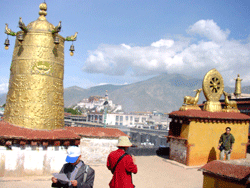Tibetan Religion
Religious belief
 Almost all Tibetans follow Tibetan Buddhism Tibetan Buddhism is called “Buddhism” by the local Tibetans, without any words to qualify it. Elsewhere in the outside world it is know as Lamaism, Tibetan Buddhism etc.
Almost all Tibetans follow Tibetan Buddhism Tibetan Buddhism is called “Buddhism” by the local Tibetans, without any words to qualify it. Elsewhere in the outside world it is know as Lamaism, Tibetan Buddhism etc.
Before Buddhism was introduced into Tibet, Tibetans followed the primitive Bo religion (also known as Bon or Black religion), mainly concerned with driving out evil spirits and divining luck.
Buddhism spread from the Central Plains and Nepal into Tibet during the 7th century, particularly during the ZhenGuan years of Tang Dynasty (Zhen Guan was the name given by the emperor to symbolize the years when he reigned).
Songtsan Gambo (a king in Tibet) was influenced by his wives Princess Khridzun of Nepal and Princess Wencheng of China's Tang Dynasty towards Buddhism. He also began the creation of Tibetan calligraphy and the translation of Buddhist scriptures. Thus Buddhism rose in popularity in Tibet while Bon went into decline. Buddhism spread quickly, and has exerted an extensive and profound influence on the Tibetan race in terms of Tibetan values, morals, psychology and the mode of thinking.
In the late 8th century, in order to shield and sustain Buddhism, Trison Detsan built many monasteries and translated a large number of Buddhist scriptures. He invited Zhibatsho and Padmasambhava, famous Indian monks, to carry forward the spirit of Buddhism. Padmasambhava combined elements from the Indian Esoteric Sect with the Tibetan primitive Bon religion to form “Tibetan Esoteric Buddhism”(or Tibetan Tantrism). Since then, Tibetan Buddhism separated from the Central Plains, and although deeply influenced by Indian Buddhism developed a style of its own.
In 837 BC, the Tibetan King Tritso Detsan was assassinated and Langdarma, who was supported by Bon forces, ascended the throne. He persecuted Buddhists, forced monks and nuns to resume secular life and was later killed by Buddhists. Though Langdarma had only reigned in Tibet for four years, he brought great destruction to Tibetan Buddhism.
After the strike, Tibetan Buddhism had been quiet for more than a century and it began to revive at the beginning of the 11th century. After the mid-11th century, numerous Buddhist Acts emerged, including the Nyingma, Sakya, Kagyu and Gelug sects and since then Buddhism prospered again. It was the prevailing period of Tibetan Buddhism. At the time many different independent sects appeared.
The doctrine of the Tibetan Buddhism is based on the Mahavairocana-sutra and the Kalacakraindriya-sutra but priority is given to Mahavairocana-sutra. The four Characteristics of Tibetan Buddhism are the constant practice of its paternoster; highly respect to Lamas; beliefs in reincarnation and the combination of religion and politics.
Four main sects
One of the main Characteristics of Tibetan Buddhism is that: During a long time in the history, Tibetan kings reigned with a combination of religion and politics. Most Tibetan people believe in Buddhism and they are devout to it. It has a strong mysterious color, especially with the reincarnation system which is a distinct feature of Tibetan Buddhism. Tibetan Buddhism focuses on religious practice and has a large number of followers. Numerous Buddhist Acts emerged during a long time of development, including some main sects as Nyingma, Gagyu, Sakya and Gelug sects.
Read details of the four main sects
The Panchen and Dalai Lamas
Dalai and Panchen are two Living Buddha systems of the Gelug Sect (the Yellow Sect). Tibetan Buddhism circle believe that the former is the incarnation of Chenrezi (Buddhism Guanyin), and the latter of Amitayus (Buddha of Infinite Light).
In Tibet, most monasteries as well as ordinary Tibetan families enshrine and worship the statues or portraits of Dalai and Panchen Lamas. Tibetans say that Dalai and Panchen are just like the sun and moon in the sky. Being given the latest color photos of Dalai and Panchen by tourists, the faithful believers will receive in both hands, hold above their heads and reward with particular enthusiasm.
Read more of the Panchen and Dalai Lamas
Read also Six-word Mantra